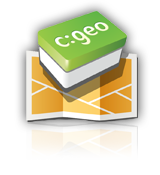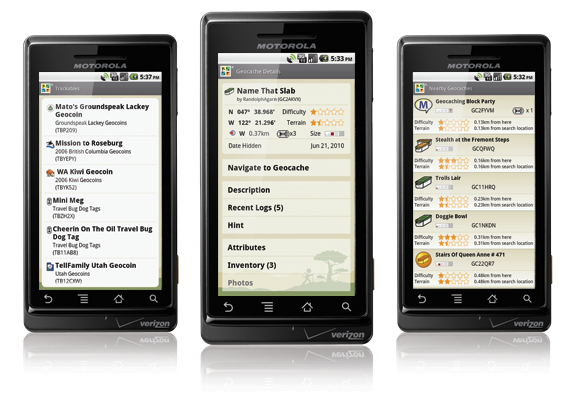Maps, more Maps, and a Crippled App.
It has been a while, nearly a month or more, so it is past time that I get back into things.
The most notable change in the last month? Maps. Many will notice a change. Groundspeak does not claim that these are an upgrade, but a change.
Why the Change?
The maps came about when Google instigated a new policy that they announced last fall that they would start charging the heavy users for use of their map API. Well groundspeak delayed as long as they could before they had to actually start paying Google. So they dumped the maps for new ones. The change is not everywhere, but in many places. I expect that it will expand through other services (waymarking, cache creation pages, etc). They just pulled the heavy users at the moment. Every cache page was pulling up two Google maps. I had noticed a month or so ago that the smaller map high on the page was no longer Google, but did not give it any thought at that time.
 The only actual statement of cost that I have heard from a lackey is that it would cost "a few million dollars" and maybe more. I have heard numbers from different people tossing about $10,000 to well over $3 million. The $10,000 number is the low price of licensing through Google. Groundspeak is a very heavy user, that averages over 2,000,000 hits per day. I would guess that on big holiday weekends, that number may be 150-200% of that number, and the game is only growing. I will stick with the "few million dollars" as only Groundspeak and Google know what the usage is and what the costs may be.
The only actual statement of cost that I have heard from a lackey is that it would cost "a few million dollars" and maybe more. I have heard numbers from different people tossing about $10,000 to well over $3 million. The $10,000 number is the low price of licensing through Google. Groundspeak is a very heavy user, that averages over 2,000,000 hits per day. I would guess that on big holiday weekends, that number may be 150-200% of that number, and the game is only growing. I will stick with the "few million dollars" as only Groundspeak and Google know what the usage is and what the costs may be.
That being said, how many users are there? and income from them? This is only conjecture at this point. Cacherstats.com tells us that there are 165,000 cachers that have ever found over 200 caches. There may be 5,000,000 users, but most are casual, or do not log. I decided to say only 50% are paying members. I am sure a few players under 200 finds are premium members, but many over 200 have left the game in the past decade, and found new hobbies. (at least around here) or are a family with many accounts and only one or two premium accounts.
So that leaves us with 85,000 paying customers. That would be $2.5 Million dollars of income. So paying millions or even one million in fees to Google hurts the company severely. Groundspeak has a number of programmers, Customer Service, Legal Council, server and bandwidth costs. They have worked hard to improve the game, and laying off 1/3 to 1/2 of its staff would not be helpful to the game.
What Happened?
There are a few things to look at. There are three main maps that were on Geocaching.com that I recall. The old map page, the "beta" maps, and on the cache page. Those were the big hits (I am guessing).
Well the old map page went away. Groundspeak had been phasing it out for a while now, and getting the new maps ready. There was no reason for them to continue, and keeping it with a new map set would have meant reprogramming the page. No big deal, but it was at the end of its life, so it was left to Die. This had a side effect apparently (see below).
The Beta maps became the new map page. In the upper right corner is where you can shift between map layers. Personally i do like the OpenStreetMaps.
For satellite views? I moved to Google Earth, again. There are instructions on how to use them here. http://www.geocaching.com/about/google.aspx In Google earth I have KML files of Indian Lands, Wilderness areas, National Parks, and i get a cool 3D view. Makes it easy to decide if I want to hike if I can see how high the hills actually are. I forgot how cool this feature really is.
Open Street Maps
 OpenStreetmapsI find these really cool, mostly because I find maps are cool. Plus I get to work on them and add to them. I always hate maps that do not have roads, or are mission places. I went into Springville, and have added many roads, train tracks, churches, parks, etc. It is a fun project to kind of play with. The bright side.. you can make your maps better.
OpenStreetmapsI find these really cool, mostly because I find maps are cool. Plus I get to work on them and add to them. I always hate maps that do not have roads, or are mission places. I went into Springville, and have added many roads, train tracks, churches, parks, etc. It is a fun project to kind of play with. The bright side.. you can make your maps better.
It took me a bit to figure out, but for the most part it is pretty simple. There are a number of tutorial aids to explain how to do it.
I am not sure if I understood correctly, but someone told me that when groundspeak gets its own tile server up and running that OSM will be set as the default. Hopefully that is true, Mapsource is not bad, but OSM is far better.
C:geo
 When the site was upgraded and the old map page was tossed into groundspeak refuge pile for old web pages there was a side effect. C:geo the site scraper was tossed into turmoil. Apparently from reading their website and emails from one of the people working on the project they pulled from the old map. Getting the location and type of caches from that page.
When the site was upgraded and the old map page was tossed into groundspeak refuge pile for old web pages there was a side effect. C:geo the site scraper was tossed into turmoil. Apparently from reading their website and emails from one of the people working on the project they pulled from the old map. Getting the location and type of caches from that page.
Well with that map gone, they cannot do that any more. The new map operates in a different way. They are working on a fix, but they will be up to 150 feet off at times (50m), depending on your view. It also will not tell you what type of cache is there at that location.
You can load a PQ into it and it will work fine (I did not try that). I pulled it off my phone yesterday in frustration. I may reinstall it, but it is too cold to go caching right now (snow is on the ground from this last week).
Here is the thing. GC.com did something we were afraid for some time now. Live map was changed and old maps was also removed. c:geo relied on this old maps to get data.
In other words they felt that the old maps (the page not the Google maps) were going away. Yet apparently no plans were in place to work on the new set. Originally carnero (the original developer) was looking into the API before stopping development of c:geo and turning it over to a group. The new group has repeatedly said that the API would harm the non-premium members. So they chose not to dive into it. They
Statement on the live maps and development from them. - Here is a clip from that
In a fast, short and not good online meeting for c:geo people come up with this. Live map will come back, but it will never be the same again. It should be fast with 2 problems.
When a cache will be opened all details can be loaded, including type (traditional, multi, ...) and exact coordinates. Approximate time to implement this is something between 2-6 weeks.
- all caches on live map will be inaccurate (+-50m or so), depending on a zoom level
- type of all caches on live map will be unknown
Well, they made the decision. I am going to play with other Android services that use the API. I may review a few of them here. I have not looked at anything other than c:geo and the groundspeak app in the last year or more.
This is from the API Statement Read more here
What would change with the API?
- c:geo only for premium members
- no support for OpenCaching or other platforms than gc.com
- Groundspeak-ads
Also there are problems with development:
- development would take 2-4 months to implement the API
- during this time there would be only access to a testing-server, no nightly-builds
- devs are using the development-build for caching
- the API requires a private key for the app. But c:geo is open-source. There are a lot of independent developers, but only one would get the key - all other developers wouldn't be able to test what they do
- c:geo no longer open-source
- only few core-developers
- much slower development
Now What?
So that is where we are now. Groundspeak and C:geo are trying to decide what is next, people are trying to figure out the maps, and geocaching goes on. I hope to get out and make a day of it soon. If the snow will go away long enough for me to, or I take a trip to get away.
See you at the cache, and remember to have fun.



